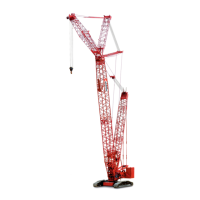National Crane Published 12-21-2012 Control # 103-06 3-11
1400A OPERATORS MANUAL OPERATING CONTROLS & PROCEDURES
NOTE: The load charts shown in this manual are examples
only. See the load charts attached to the crane for
actual values.
• The load chart (Figure 3-8) is used to determine the
weight limit of the load based on the load radius and
boom angle. All lifting devices must be included when
determining the weight of the load.
• The range diagram (Figure 3-9) shows the operating
radius and the height from horizontal of the unloaded
boom.
• The hoist data chart (Figure 3-10) shows hoist capacity
and multipart line reeving. The correct reeving for all
loads listed in the load chart is also shown.
Before you can determine the crane configuration you need
to know:
• the weight of the payload.
• the lifting devices needed.
• the height of the lift.
• the horizontal distance from the center of rotation (load
radius) to where the load is to be placed.
To determine the safe operating parameters you need to:
1. Get the weight of the payload.
2. Approximate the load radius. This is the horizontal
distance from crane center of rotation to where the
payload is to be placed.
3. Determine the lifting devices and hook block reeving
using the hoist data chart.
4. Calculate the combined weight of the lifting devices and
payload.
5. Determine the boom angle and length from the range
diagram using the height and load radius of the lift.
6. In the load chart, take the load radius and boom angle/
length column over to the weight column and check the
weight. If the weight is between two values, use the
lower value.
LIFTING THE LOAD
The following general guidelines outline the proper
procedure for making a lift after the crane has been properly
set up.
1. Position the crane in the work area and set the
outriggers. See See “Outrigger Setup” on page 1.
2. Program the RCL. Use the load chart to estimate the
values.
3. Position the boom nose over the load. Do not try and
drag the load with the boom or hoist.
4. Perform the lift. Meter the controls when moving the load
to avoid sudden stops.
5. Retract and lower the boom after the lift is complete.
Unattended Crane
The configuration in which the crane should be left while
unattended shall be determined by a qualified, designated
individual familiar with the job site, configuration, conditions,
and limitations.
SHUT DOWN AND PREPARATION FOR
ROAD TRAVEL
1. Retract and place the boom in boom rest with the hook
block slightly ahead of the front bumper.
2. Retract the front stabilizer.
3. Retract the outriggers and stabilizers.
4. Remove the stabilizer pads and place on the stowage
brackets located on the side of the stabilizer.
5. Connect the hook block to the tie-down cable so that it
cannot swing freely.
6. Secure the hook block and anti-two-block weight:
a. Slowly hoist up until there is a slight tension on the
hoist cable. It may be necessary to override the anti-
two-block function to tension the cable.
b. The the anti-two-block weight needs to be resting on
the wedge socket so that there is slack in the anti-
two-block-chain.
NOTE: There needs to be enough slack in the anti-two-
block chain so that the anti-two-block switch does
not switch between open and close during travel.
If the chain is too tight, road bounce causes the
anti-two-block switch to open and close numerous
times and this can damage the switch.
WARNING
Tipping Hazard!
Changing weather conditions including but not limited to:
wind, ice accumulation, precipitation, flooding, lightning,
etc. should be considered when determining the location
and configuration of a crane when it is to be left
unattended.
Failure to comply with these instructions may cause death
or serious injury.
Reference Only

